
Sternhalma, commonly known as Chinese checkers or Chinese chequers, is a strategy board game of German origin that can be played by two, three, four, or six people, playing individually or with partners. The game is a modern and simplified variation of the game Halma. "Complexity: requires no counting or spelling; even young children can play."

Ludo is a strategy board game for two to four players, in which the players race their four tokens from start to finish according to the rolls of a single die. Like other cross and circle games, Ludo is derived from the Indian game Pachisi. The game and its variations are popular in many countries and under various names.

Xiangqi, commonly known as Chinese chess or elephant chess, is a strategy board game for two players. It is the most popular board game in China. Xiangqi is in the same family of games as shogi, janggi, Western chess, chaturanga, and Indian chess. Besides China and areas with significant ethnic Chinese communities, this game is also a popular pastime in Vietnam, where it is known as cờ tướng, literally 'General's chess'.
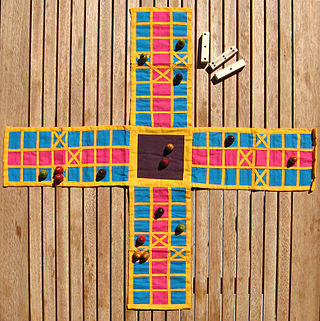
Pachisi is a cross and circle board game that originated in Ancient India. It is described in the ancient text Mahabharata under the name of "Pasha". It is played on a board shaped like a symmetrical cross. A player's pieces move around the board based upon a throw of six or seven cowrie shells, with the number of shells resting with the aperture upward indicating the number of spaces to move.

Parqués is the Colombian version of a board game in the cross and circle family. The game is described as a "random thinking" game: the moves depend on the roll of the dice but players must consider possible strategies before executing their move. The objective of the game is to advance all the pieces to the end. Once in the safety zone player can use 2 dice until they are one space away from home, where they will then just use one die.

Parcheesi is a brand-name American adaptation of the Indian cross and circle board game Pachisi, published by Selchow & Righter and Winning Moves Games USA.
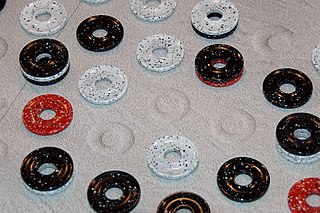
DVONN is a two-player strategy board game in which the objective is to accumulate pieces in stacks. It was released in 2001 by Kris Burm as the fourth game in the GIPF Project. DVONN won the 2002 International Gamers Award and the Games magazine Game of the Year Award in 2003.

GIPF is an abstract strategy board game by Kris Burm, the first of seven games in his series of games called the GIPF Project. GIPF was recommended by Spiel des Jahres in 1998.

Djambi is a board game and a chess variant for four players, invented by Jean Anesto in 1975. The rulebook in French describes the game, the pieces and the rules in a humorous and theatrical way, clearly stating that the game pieces are intended to represent all wrongdoings in politics.

Chu shogi is a strategy board game native to Japan. It is similar to modern shogi in its rules and gameplay. Its name means "mid-sized shogi", from a time when there were three sizes of shogi variants that were regularly being played. Chu shogi seems to have been developed in the early 14th century as a derivative of dai shogi. There are earlier references, but it is not clear that they refer to the game as we now know it.
Whale Shogi is a modern variant of shogi. It is not, however, Japanese: it was invented by R. Wayne Schmittberger of the United States in 1981. The game is similar to Judkins shogi, but with more pieces, and the pieces are named after types of whale.

PÜNCT is a two-player strategy board game. It is the sixth release in the GIPF project of seven abstract strategy games, although it is considered the fifth game in the project. It was released in 2005. PÜNCT won the Games Magazine Best Abstract Strategy game for 2007.

Uckers is a board game for two to four players traditionally played in the Royal Navy. It has spread to many of the other arms of the UK Armed Forces as well, including the Commonwealth Forces. It can now commonly be found in the Royal Marines, Army Air Corps, Royal Canadian Navy, Royal New Zealand Navy, Royal Australian Navy, Royal Australian Air Force (RAAF), Royal Dutch Navy, and the Royal Air Force (RAF).
Hive is a bug-themed tabletop abstract strategy game, designed by John Yianni and published in 2001 by Gen42 Games. The object of Hive is to capture the opponent's queen bee by allowing it to become completely surrounded by other pieces, while avoiding the capture of one's own queen. Hive shares elements of both tile-based games and board games. It differs from other tile-based games in that the tiles, once placed, can then be moved to other positions according to various rules, much like chess pieces.
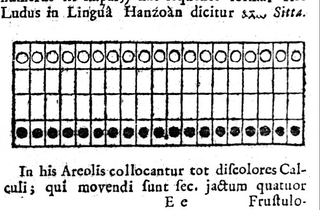
Tâb is the name of a running-fight board game played in several Muslim countries, and a family of similar board games played in North Africa and West Asia, from Iran to West Africa and from Turkey to Somalia, where a variant called deleb is played. The rules and boards can vary widely across the region though almost all consist of boards with three or four rows. A reference to "al-tâb wa-l-dukk" occurs in a poem of 1310.

TZAAR is the seventh game released in the GIPF series and Games Magazine's 2009 Game of the Year. It officially replaced TAMSK, which was originally published as the second board game in the GIPF Project.
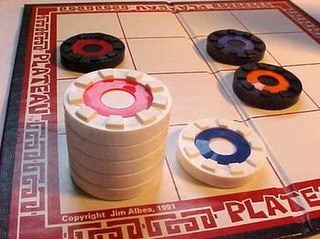
Plateau is a two-player abstract strategy board game invented by Jim Albea.
Portal chess is a chess variant which uses at least two fairy pieces called portals. These pieces can be easily added by using poker chips, coins or other suitably sized objects. The game seeks to incorporate portals to allow pieces to teleport around the board. Apart from the portals and their ruleset, the game often plays like ordinary chess, including the en passant capture, castling, and promotion.
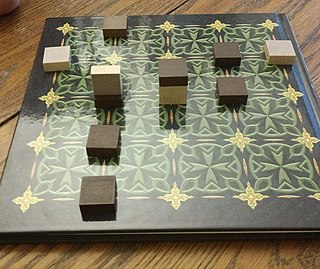
Tak is a two-player abstract strategy game that first existed fictionally within Patrick Rothfuss's fantasy trilogy, The Kingkiller Chronicle and was then brought to life by James Ernest in collaboration with author Patrick Rothfuss and published by Cheapass Games in 2016. In 2021, Tak was incorporated as an event in the international Mind Sports Olympiad.















